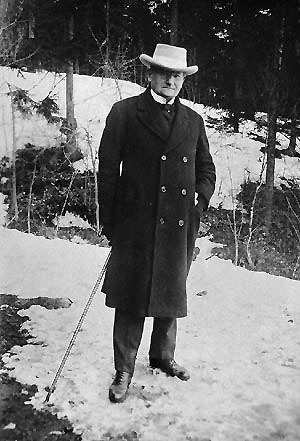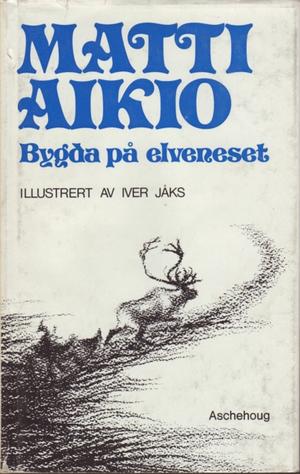Why hadn’t I heard of Matti Aikio before? Not only is his writing interesting and an important part of Norwegian history, but he as a person sounds fascinating. Born in Karasjok in 1872, Matti Aikio was Sami with all that entails in 1870s Karasjok. Despite the position Sami had in Norway at the time his father had a high position in the village, even being mayor for a time. Matti was educated and worked for a time as a teacher, then a journalist. Matti was in a sense a typical case of caught between two worlds. He was bright, really really bright from what I can tell, and because of this he had options. He travelled south to Oslo and tried to integrate into the Norwegian majority culture. As the open, charming person that he was (or at least described as) he managed to get a position in the cultural sphere, but he would never be able to shake off the fact he was a Sami. In this setting he gave out his first body of work King Ahab in Denmark 1904. Though if you asked anyone, even Matti, they would present In Reindeer Hide (1906) as his literary début. With the publishing of In Reindeer Hide Matti changed. He was now an established journalist and he started writing travel logs from the North. Presenting the Sami culture to the Norwegian majority. His last book The village at the Riverbend was finished, but not published in his time.
was Sami with all that entails in 1870s Karasjok. Despite the position Sami had in Norway at the time his father had a high position in the village, even being mayor for a time. Matti was educated and worked for a time as a teacher, then a journalist. Matti was in a sense a typical case of caught between two worlds. He was bright, really really bright from what I can tell, and because of this he had options. He travelled south to Oslo and tried to integrate into the Norwegian majority culture. As the open, charming person that he was (or at least described as) he managed to get a position in the cultural sphere, but he would never be able to shake off the fact he was a Sami. In this setting he gave out his first body of work King Ahab in Denmark 1904. Though if you asked anyone, even Matti, they would present In Reindeer Hide (1906) as his literary début. With the publishing of In Reindeer Hide Matti changed. He was now an established journalist and he started writing travel logs from the North. Presenting the Sami culture to the Norwegian majority. His last book The village at the Riverbend was finished, but not published in his time.

Out of these three King Ahab is the odd one out. In Reindeer Hide, which gave him huge literary acclaim is read very much like a journalistic piece. Having a huge cast, it seems he is more focused on the place and the people, rather than characters and plot. The huge cast is trying to reflect a sense of ‘one of each’ mentality. The writing is colourful and deep, especially his description of the harsh winter climate. I can understand why majority Norwegians was so fascinated with this book. This would have been an introduction to something ‘exotic’ and ‘foreign’, but not in a way that would alienate them. There is no cry for justice or sympathy in a way that would make the ruling class uncomfortable. At the same time, he presents the characters as real people, not really stereotypical (even if he has the ‘one-of-each’ syndrome). Some literary critic has talked about how Matti is very critical to the Sami people. They probably know that better than me, but I was sad that the huge cast left me feeling unable to connect to any of the characters. I constantly had to go back to check who this or that person was, until I gave up and just saw it as snippets in a documentary.
This problem is a bit better in The village at the Riverbend. He still writes as a journalist and

still has a huge cast, but he seems more interested in his characters this time around. Spending more time with them and giving them more story. I still wanted more of their emotions as the books are very ad hoc regarding what emotions we are privy to. This could get frustrating as I then didn’t understand a character’s motivations. Example is that one of the characters get pregnant outside of wedlock. She is worried that this and that person will judge her. I get that. Then she comes back and gets a lot of proposals, including from the people she was worried would judge her. And she turns them all down, because it turns out she is in love with this person all along. Being privileged to her worry, but not why she turns all of them down (not even that she is confused or anything like that) makes me as a reader unsure about where the characters stand. It seems Matti only did this so he could describe to us how the Sami propose, as a cultural factoid. Now I know that cultures communicate differently, some more directly than others. Norwegian majority culture has a very directly way of communicating. I don’t know if the Sami culture includes a more indirect way of communicating, and therefore there are a lot of information going over my head, or if Matti just isn’t interested in this aspect of his books. Besides this The village at the Riverbend is no doubt he best written book, technically. The descriptions aren’t just deep, but much more alive and poignant. You feel not just that you’re there, but that these people are living, breathing interesting people.
King Ahab has everything I missed in the two other books. It’s a much smaller cast, we follow the Captain, whom is very jealous of his cousin, because his cousin is preferred by “everybody”. This jealousy has festered in him and become hate. The book then follow him when he hires a home-school teacher for his daughter, Falkenberg, whom is half Sami. Falkenberg’s Sami identity is referenced in the book, but it’s not a book about him being Sami. The emotions in the book are palpable and the characters identifiable. The biblical connection with the story of King Ahab from the book of kings is also surprisingly well done. The only complaint is that the book isn’t longer so we can get to know these people more, and the writing. The writing isn’t bad, but it’s clear it’s his first book. This drastic change was probably exasperated by the fact that I read The village at the Riverbend just before I read this one.
A perfect book would have been King Ahab written with the experience shown in The village at the Riverbend.
